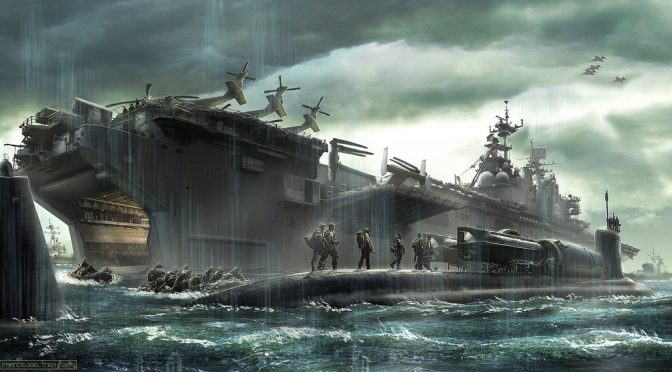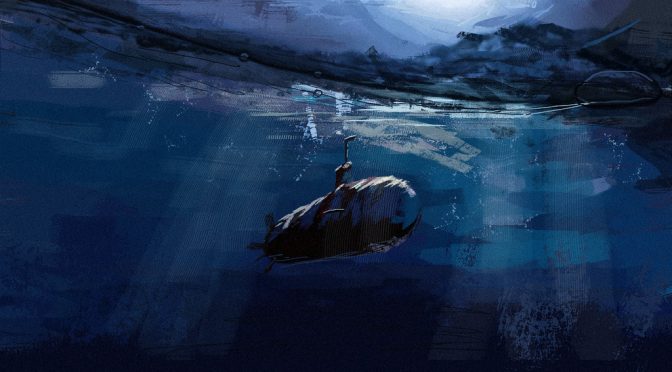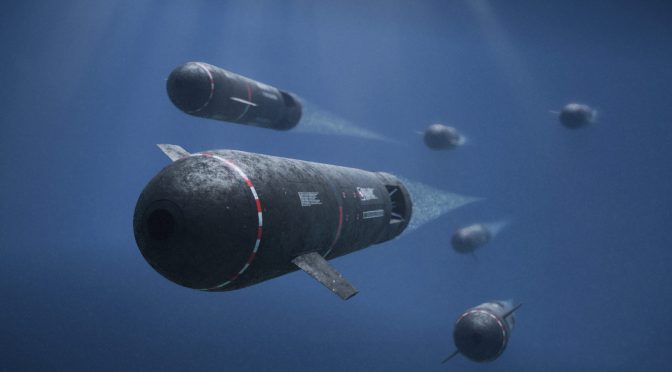By Mike Barretta
First Lieutenant Gabrielle Cruz (USMC) is an unexceptional student. Unexceptional, however, is contextual. She is fluent in two languages, graduated with honors from LSU, earned a degree in petroleum engineering, and volunteered for military service during wartime. She is unexceptional because as I look around the squadron’s ready room much the same could be said about every other flight student.
During the brief, she listened attentively and asked the same questions that I’ve fielded from previous students. In turn, she correctly answers my questions. It’s a good start to the flight. She is an attractive woman. Dark-skinned. Dark-haired. Closer in age to my daughter than she is to me. Usually the briefing space smells like fear-tinged sweat and dry erase markers, but with female students, it smells of soap and shampoo. It is a distinctly different military than the one I joined fifteen years ago.
Once, while I was with my wife, I saw her in the Cordova Mall enjoying a brief respite from training. As we passed, she said hello. With her hair down, made-up face, and civilian clothes, I didn’t recognize her. The Marines do a remarkable job of standardizing their officers. They will make you a man even if you are a woman, and the process was only half-finished with First Lieutenant Cruz. An aura of femininity stubbornly clung to her.
I would have hoped that an attractive young woman approaching me in the mall would arouse some reaction from my wife.
“One of your students?” asked my wife
“Yes,” I replied.
“She’s pretty,” said my wife.
“I hadn’t noticed.” I said.
“You’re an idiot,” said my wife.
“I’m not lying”
“Yes, you are.”
I was lying. There in the mall, I couldn’t help but notice her on her terms. She is sleek and menacing and confident. A backwards glance over her shoulder would stop a younger man’s heart mid-beat or make an older man, such as myself, tighten his stomach just a bit.
“Let it out,” says my wife.
“What are you talking about?”
“You’re impossible.”
Seven hundred feet above Spencer field, she is neither sleek nor menacing, but just as fatal to me. Underneath a white helmet, visor down, she looks like a ferocious pixie bobble-head. All I can see of her face is a light dusting of freckles on her cheeks and a glistening bead of sweat hanging from the tip of her nose.
She is my On-wing, which means that I am responsible for teaching her the basics of helicopter flight. This is her last flight with me before her performance and, by insinuation, my own, will be evaluated by another instructor before she can solo the aircraft. For the past two weeks, I have taught her the fundamental attributes of a competent pilot: Situational awareness, knowing what is going on around the aircraft, and basic airmanship, the ability to make the aircraft perform as desired. She flies well, but not perfect. Perfection is the province of God and by definition unattainable. The best any pilot can do is to exist in a constant state of correction.
The flight is nearly over and I can tell from her relaxed posture that she knows she has passed. As far as she is concerned, all she needs to do is fly straight-and-level back to Whiting field. I almost feel bad about what I am going to do. In about fifteen seconds, the time it takes to hit the ground from 700 feet, we are both going to find out how good of an instructor I am.
She squeezes the radio trigger to announce her intention to depart Spencer and return to Whiting Field.
“Spencer, Eightball one eight eight…..”
Before she gets the chance to finish the radio call, at the maximum point of distraction, when she must talk, fly, and think, at the same time, I roll the engine to idle to simulate a failure. The engine fades to a dull pointless drone. Gauges droop to their resting state. Rotor speed decays.
“Simulated,” I say.
The worst possible outcome is that she exceeds my ability to correct her and we hit the ground with sufficient vertical velocity to bend metal and shatter bone. It is the wrong time and place for doubt. We fall out of the sky at over two thousand feet per minute and her initial response is to maintain the correct attitude. In aviation, attitude refers to the orientation of the aircraft to the ground. In life, attitude refers to the orientation of the person to the problem. At this moment, she needs both. She lowers the collective to maintain rotor speed and pushes the nose over to maintain airspeed. The cyclic slams against my right leg, and the aircraft rolls to a 45 degree angle of bank. It isn’t enough to reach the field, so she increases the roll to 60 degrees, the limits of the aircraft. From my vantage point, it is as if Spencer field is rotating around us. Dusty, mid-summer grass fills the windscreen as we fall. First Lieutenant Cruz is in a furious state of constant correction. She is observing her environment, making prioritized value decisions, and acting upon them as if her life depended upon it. It does. Over the intercom she repeats, “Attitude, N, R, Ball,” the mantra that describes the path her eyes take as she scans the instruments and outside world.
At 100 feet, I have an important decision to make. Should I let her continue and commit to the outcome, or take the controls? Much beyond this point, the likelihood of me salvaging a bad maneuver diminishes towards zero. She is flying the aircraft and I am watching her flying the aircraft. By definition, my reaction is behind hers. My only advantage is experience.
At 75 feet, she flares the aircraft, pulling the nose up, pitching to the sky. The ground blossoms beneath us. Airspeed bleeds towards zero and rotor speed builds under the influence of inflowing air. The aircraft drops and my hands rest lightly on the controls. At 5 feet, she pulls sharply on the collective to reverse the flow of air and cushion the landing. Rotor speed droops to 85 percent, the bare minimum to sustain flight. She adjusts the pedals to align the aircraft with the direction of travel and levels out. All at once, we have run out of altitude, airspeed, and options exactly as it is supposed to happen. The aircraft touches down with a slight bump and slides across the grass.
I look over at her and she is grinning from ear-to-ear. I know exactly how she feels because fifteen years previously some forgotten flight instructor taught me the same maneuver. She knows she has done well and I want to share the moment with as much elation as is boiling inside her. Instead, I say, “Good job, but……..” and I launch into a critical review of her performance.
Usually an On-wing and I will fly once or twice more before they get their wings, but I never flew with her again. About six months after we last flew, she knocked on my office door. Her face is a little leaner, her posture more square, some would say that there is a bit less of her and a little bit more Marine.
“Mr. Barretta, I’m getting winged this Friday.”
“Congratulations.” In the back of mind, there was never really any doubt.
“What did you select?”
“Cobras, west coast, my first choice.”
“Cobras, that’s awesome.” All the Marines want Cobras. Bell helicopter, the manufacturer, says they made the Cobra beautiful because it is the last thing the bad guys will ever see. When she flies her Cobra over moonlit desert or triple-canopy jungle, she will be a predator. Cobras don’t rescue anybody.
“Anyway, the soft patch is this Thursday and my parents and grandparents are flying in. I was hoping you would be able to patch me.”
“I would be happy too,” I say.
The soft patch is an informal ceremony the night before the official winging. Parents and friends gather and a student is called up with his or her instructor. The velcro leather name tag the student wore while in training, emblazoned with service insignia, is ripped off and a new leather name tag with Naval Aviator wings is “tacked-on,” with a punch. Funny or fast stories about the students are told and the instructor is given a bottle of their favorite liquor.
“Thank you, sir.” What do you like?”
“I am a little short of Grey Goose.” She smiles. During a lighter moment she had told me how she got sick on Grey Goose at a party.
At the soft patch ceremony, I find her sitting at a table with her parents and grandparents. Her father is prior Army enlisted as was her grandfather. Her grandfather was at Hickam Army Air Force Base on December 7th 1941. I shake both their hands. I give her mother a small framed poem called: The Fighter Pilot’s Prayer. It reads: Dear Lord, Give me the eyes of an Eagle, the Heart of Lion, and the Courage of a U.S. Marine Corps Helicopter Pilot. It’s a small thing and I do it for all my soft-patchees.
Her mother smiles and thanks me and I tell them what they already know: That their daughter did well. I excuse myself to grab a reinforcing beer. My stories are famous for being funny, but I’ve never really gotten comfortable telling them in front of 80 or 90 people. The beer helps. When it is our turn, we meet each other at the front of the room. She is nervous and excited.
She hands me a bottle of Grey Goose and I set it aside. I tell a funny story. It is entertaining, embarrassing, and completely fictitious. I don’t owe anything to reality. She can’t do anything, but smile and take it like a Marine. Students attempting to defend themselves are booed down by the cadre of instructors lured in by free beer. The laughter ends and I find her new leather patch. Above her name are Naval Aviator wings embossed in gold.
When soft-patching female students, most male instructors fumble around like they were trying to pin a corsage to the strapless gown of their prom date. I’ve learned that the direct approach is the best. I grab the corner of the worn leather patch over her left breast and tear it off. It makes a ripping sound as it pulls from her flight suit. I put it in my pocket. I keep the patches of every student that I soft patch. I smooth the new patch on and then I haul back and punch her right in the patch. Anything else would be disrespectful, a signal that she was other than what she was, a colleague, and Marine Corp Naval Aviator.
When I was winged, metal wings with two pins were placed on the uniform and then punched on without the little frogs to cover up the points. The idea was to draw blood and “tack-on” the wings so they would never fall off. The more blood the better. Over time the tradition broke under more political sensibilities, but the spirit remains.
She winces. I check her parents and they are beaming with pride and seem not to have noticed that what I had just done to their daughter could in some circumstances be considered an assault. They are a military family and they understand what just happened and why it had to be that way. I’m a bit relieved.
At the end, the ceremony devolves into small gatherings and her father works his way through the crowd towards me and I wonder if maybe he has changed his mind about the whole punching his daughter thing.
“Thank you for taking care of my daughter,” he says.
“She took care of herself,” I say.
“We know. We know,” he says, and he fades back to his family.
“Did you hear?”
“About what?” I ask.
“West coast Cobra crash.”
“No, who was it?”
“Cruz. You remember her?”
“Yea, she okay?
“No, her and the FRS instructor were killed.” The FRS is the Fleet Replacement Squadron that transitions newly winged aviators to their fleet aircraft.
“How?”
“Bird strike took out the tail rotor on a goggle flight.” Contrary to popular belief, birds do fly at night and with the reduced field of vision that comes with flying on night vision goggles there was no realistic chance of avoiding a collision.
“Thanks for telling me.”
“I thought you would want to know.”
Really, I could have gone the rest of my life not knowing, but in the long run there is no way to not know. Mishaps are ruthlessly examined and disseminated. Talking about the dead is a requirement of the job. Sooner or later, I would have found out.
At home, I open the bottle of Grey Goose hiding in the back of the freezer. The vodka has a sluggish oily look to it. I retreat to my study and the quiet of the house intensifies. I usually stay up late to sit and think when the kids have finally fallen to sleep. I sit in my chair and sip the freezing cold vodka and it is good. Ghosts recline in the chair opposite me. They are young and beautiful with pale eyes. John Brown killed in a T-34 Crash, Dave Pidgeon killed in an A-4, the guy I can only remember as Jasper, the two killed when their gyros failed on a dark night, many others, about twenty five in all, including a newly-promoted Captain Gabrielle Cruz. I wonder what bizarre combination of skill, luck, and grace conspired to let me survive a career that took so many away. Some lie buried beneath white crosses and manicured lawns, some in shaded family plots, some lost forever to the sea.
Some sit across from me.
I know exactly what went on in her cockpit. First, there is the sudden unexplained thump, a high frequency vibration in the pedals, and then the nose breaks free, spinning rapidly to the right. She pushes full left pedal to stop the yaw and it is useless. Her heart keeps rapid time and she is flushed with adrenaline heat. Maybe she does everything right. Maybe she doesn’t. Near the final moment, she realizes that whatever she is doing is not enough and she hopes that she is merely a witness to the experience rather than a participant. She falls into the dark, illuminated by urgent lights, and then it is over as if she never was.
“Who are you talking too?” asks my daughter.
“No one.” The ghosts shift away from reality. I look over at the doorway and she is standing there, young, long-limbed, and present. She looks like her mother when we first met. “I’m okay, just thinking.”
“You’re weird. Can you help me with algebra?”
“Can I help you tomorrow?”
“Yea, I guess. When am I ever going to use it?”
“All the time.”
“You’re lying.”
“I am.”
“Well, maybe I’ll join the Navy and fly helicopters like you.”
“Maybe you will,” I say.
She enters the study and bends over to kiss me on the cheek. Her hair caresses the sides of my face like a ghost’s touch and I can smell the shampoo and it reminds me of someone I flew with once. “Goodnight,” she says as she leaves
Please God, I hope not, I add in silence. There is only so much luck and skill and grace in the world to go around and I have used far more than I had any right to and someone had to be shorted.
Maybe someone was.
With an overly generous measure of Grey Goose warming me, I know it to be true. As naval aviators, all of us will fly, some of us will fight, and few of us will die, and it seems that there is nothing more of it. I finish the Grey Goose. If I turn my head just so, I can see a ghost sitting at the edge of vision. I think ghosts are mirrors, reflecting only what is in front of them. This one is the pale color of grief. I turn my head a bit more and the ghost is gone.
Mike Barretta is a retired naval aviator who works for a major defense contractor. He holds a Masters degree from the Naval Postgraduate School in Strategic Planning and International Negotiations and a Masters degree in English (creative writing) from the University of West Florida. His stories have appeared in Apex, Redstone, New Scientist, Orson Scott Card’s Intergalactic Medicine Show, and various anthologies including the Young Explorer’s Adventure Guide, War Stories, and The Year’s Best Military Sci-fi and Space Opera.
Featured Image: AH-1Z Viper attack helicopter by David Roterberg




